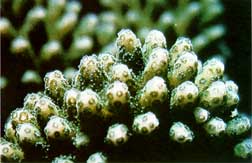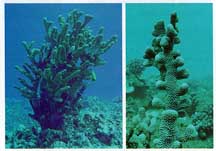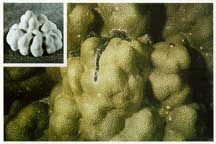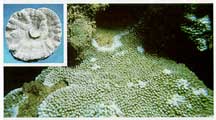Coral and Live Rock Rules of Hawaii
Stony Corals
Stony corals are defined by administrative rule as any species belonging to the Order Scleractinia (marine corals which generate a hard skeleton). All reef corals, including mushroom corals, belong to this order.
The animals which form stony corals belong to the same major group as jellyfish and anemones. Most of them are coIonial, and all secrete a hard skeleton made of calcium carbonate. The animals themselves, called polyps, form the outer living layer of a coral colony. Each polyp sits in a cup-like depression called a calyx (pl. calices).
The characteristic color of many living corals is due to the presence of single-celled algae, called zooxanthellae,which live inside the coral polyp. The coral and algae have a mutualistic symbiotic relationship in which each benefits from the other. Most stony corals produce colonial forms that are attached to the substrate, but a few are solitary and unattached.
Coral reefs are an important resource for Hawaii. Corals and coral reefs provide food and habitat for many fish and invertebrates. Most stony corals grow very slowly, so damaged reefs may take hundreds of years to recover. Please help us to protect our coral resources. Taking or damaging coral, live rocks and coral rubble
It is unlawful to take, break or damage, with any implement, any stony coral from the waters of Hawaii, including any reef or mushroom coral. HAR 13-95-70
Rules pertaining to stony corals
Unlawful to take, break or damage, any stony coral, including any reef or mushroom coral.
Unlawful to damage any stony coral by any intentional or negligent activity causing the introduction of sediment, biological contaminants, or pollution into state waters.
Unlawful to sell or offer for sale any stony coral, except that stony coral rubble pieces or fragments imported for the manufacture and sale of coral jewelry, or dead stony coral obtained through legal dredging operations in Hawaii for agricultural or industrial puposes, may be sold.
HAR 13-95
Culturing corals
Individuals interested in culturing corals for restoration or similar purposes should read the FAQs at this link.
Live Rock
Live rock is defined by administrative rule as any natural hard substrate to which marine life is visibly attached or affixed. Virtually every hard substrate in nearshore waters has something living attached to it.
Rules pertaining to live rock
Unlawful to take, break or damage, any live rock, defined as any natural hard substrate to which marine life is visibly attached or affixed.
Unlawful to damage any live rock by any intentional or negligent activity causing the introduction of sediment, biological contaminants, or pollution into state waters.
Unlawful to sell any live rock.
HAR 13-95
Common Hawaiian Corals
 | Rose or Cauliflower Coral Pocillopora meandrina The most common Pocillopora in Hawaii, this coral prefers wave-agitated environments, and is found at depths to about 150 feet. Commonly called "rose coral" or "cauliflower coral," the colonies form cauliflower-shaped heads about 10 to 20 inches in diameter. Branches are heavy and leaf-like, and fork bluntly near the ends. All branches have wart-like projections called verrucae that are covered with calices. Color of living colonies ranges from brown to pink. |
 | Lace Coral Pocillopora damicornis This delicate and fragile coral forms small bushy clumps up to about 6 inches in diameter. Colonies consist of fine branches covered with calices. These branches range from long and slender in calm waters to more robust forms in areas of wave action. Sometimes the skeleton will create pocket formations around a crab that lives among the branches. Usually found in protected areas and inner portions of large reef flats, this species appears to strongly depend on sunlight, as it is rarely found below about 30 feet. Colonies range in color from light brown in shallow waters to dark brown in deeper waters. |
 | Antler Coral Pocillopora eydouxi Colonies consist of thick pipe-like branches that resemble moose antlers. This species also possesses verrucae and is usually found in depths of 35 to 150 feet. Live colonies are brown in color and usually darker than other Pocilloporid corals. |
 | Lobe Coral Porites lobata This coral produces many encrusting or massive forms on the reef from the intertidal zone to depths of over 180 feet. Long narrow cracks found on the coral heads are produced by a type of alpheid shrimp. Calices have a snowflake-like appearance and are shallow and flush to the surface. Living colonies range in color from yellowish-green to brown and sometimes blue. |
 | Finger Coral Porites compressa Distinguishing features are the finger-like branching and shallow snowflake-shaped calices. This species is most common in wave-protected areas like bays or deeper reef slopes to depths of about 150 feet. It has many growth forms, but all of them show some sort of fingerlike branching. Color of live colonies ranges from light brown to light yellowish-green. |
 | Rice Coral Montipora capitata The most obvious characteristic of this coral is the nipple-like projections (papillae) that cover the surface. These papillae are smooth with no calices on them. Calices are found on the upper surface of the coral between the papillae. The image of the calices and papillae create a "rice & pepper" appearance. This species is found at depths up to about 150 feet. It has a number of growth forms ranging from platelike to branchlike and encrusting types. Color of living colonies is usually brown. If the colony is growing in a plate form, the edges may be white. |
 | Mushroom or Razor Coral Fungia scutaria This solitary (single polyp), free-living (unattached) coral is most commonly found on reef flats, frequently between cracks and crevices. It has also been found at depths of over 75 feet. Its disk-like, elliptical shape resembles a mushroom cap and ranges from 1-1/2 to 7 inches in diameter. Some adults may form a high arch in the middle. Immature forms are attached to the substrate or an adult mushroom coral by a stalk. It grows into a disk and, when large enough, breaks off the stalk and becomes free-living. The color of live specimens ranges from pale brown in bright sunlight to dark brown in shady areas or deeper water. |
 | Cup or Tube Coral Tubastraea coccinea This is a common non-reef building coral found in shallow Hawaiian waters. This species forms large calices and occurs in clumps that are 2 to 4 inches in diameter. Living tissue is usually bright orange in color, but may also appear pink or even black. The bright coloration is not produced by zooxanthellae. This coral is usually found on steep ledges, in caves and in shady tidepools. |
Photos: S. Arthur Reed; James Watt; Division of Aquatic Resources
Revised May 2014
